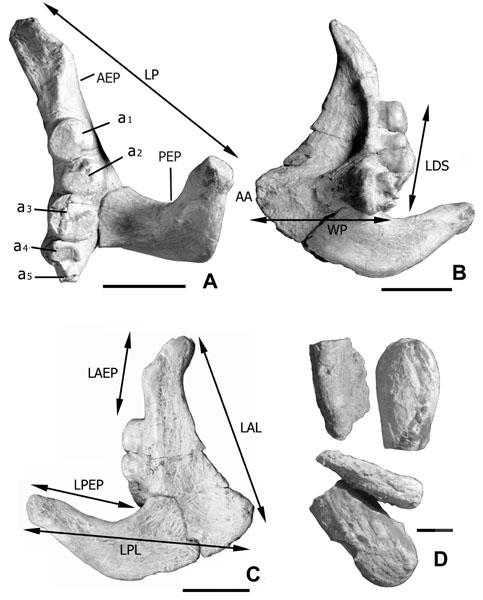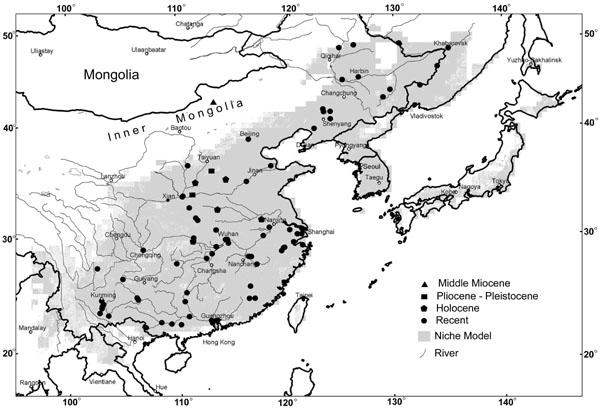Dr. CHEN Pingfu, Institute of Vertebrate Paleontology and Paleoanthropology, Chinese Academy of Sciences, and Dr. Gloria Arratia at the Biodiversity Research Center of the University of Kansas, described an oldest-known black carp, Mylopharyngodon wui, sp. nov., a completely preserved right pharyngeal bone with teeth from a middle Miocene deposit of the Tairum Nor area of Suniteyou Qi (Banner), Inner Mongolia, China.
The fossil black carp is different from the living black carp by having a generally smaller anterior angle, pharyngeal teeth a1 and a2 almost similar in size, and much rounder teeth a2 and a3.The original paper was published in the journal of Vertebrate Paleontology, 30(2):333 340, and provided some evidences for further study on the origin, evolution and biogeography of the most diversified and largest family of freshwater fish.

Fig.1 Pharyngeal bone and teeth of Mylopharyngodon wui, sp. nov. (IVPP V12533), middle Miocene, Inner Mongolia. A, dorsal view; B, inner lateral view; C, outer lateral view; D, indetermined bivalves unearthed with the holotype. Scale bars equal 1 cm. (Image by IVPP)
Cyprinidae is the largest family of freshwater fish, containing 210 genera and about 2010 species and occurring widely in Eurasia, Africa and North America. The greatest generic diversity and number of species is in China and Southeast Asia. About 210 genera and 532 species and subspecies living cyprinids have been recorded in China, and more than 28 genera and 34 species of fossil cyprinids have been reported from Tertiary sediments in China.
The earliest definite fossil cypriniforms (cyprinid and catostomid) are of Eocene age from China, but very few cyprinid fossils have been found in deposits earlier than Miocene. Most groups of the living cyprinid have appeared in the Miocene although very few belong to the living genera.
Almost all fossil cyprinids from Pliocene deposits in China can be referred to living genera, and more than half of them to living species. Although fossil cypriniforms are represented most in Asia, the study has been largely neglected in China, owing to the poor preservation of most specimens and their limited significance to the high-level systematics. The origin, evolution, and interrelationships within the Cyprinidae are still uncertain, mainly due to scarce information on fossil members of the group as well as of many extant Asiatic species.
Black carp, Mylopharyngodon Peters, 1880, is a cyprinid native to eastern Asia and represented only by one species Mylopharyngodon piceus (Richardson) , 1846, known as black carp . It is different from all other species of Cyprinidae by the presence of one row of molar pharyngeal teeth. The black carp is one of the four Chinese well pond-cultured carps , which constitute the most important part of freshwater aquiculture in China.
It was recorded and well quoted in the ancient Chinese literature as early as in the Tsin dynasty (A.D. 265-420). Living individuals of black carp may weigh 70 kg or more (Chen et al., 1998).
Recently, a large black carp of 181 cm in length and 83 kg in weight was reported. Its age was estimated at 70 years. According to the measurements of a pharyngeal bone of a black carp of 63 kg from Fuxian Lake, Yunnan, it is reasonable to extrapolate that the fossil pharyngeal bone studied here belongs to a specimen of about 37 to 43 kg.
The living black carp mainly inhabits the middle and lower layers of waters, and rarely swims to water surface. The optimum water temperature is 22-28 C. In its growing season it stays in river bends, lakes and ancillary waters, mainly feeding on mollusks and crustaceans, and survives the winter by staying in deep water.
The larvae of black carps feed on zooplankton and fingerlings, and they start to feed on small mollusks and crustaceans when they reach 15 cm in length. The powerful molar-like pharyngeal teeth and the hard callous pad permit the adult black carp to crush the thick shells of large mollusks. The fossil black carp was found near the top of the sandstone unit which is interpreted as river-bend deposits, and was associated with fossil bivalves, revealing that the black carp inhabited in clear mollusk-rich water during the middle Miocene.
The living black carp inhabits large rivers and lakes of great plains with distinctive seasonal conditions, e.g., it requires water temperature below 30 in summer and slightly higher than 4 in winter. It cannot live in high gradient rivers in mountainous regions. The gonad of black carp needs low water temperature (after summer) to get mature, and sufficient currents are required to stimulate the spawning.
Spawning only occurs in rush waters with water temperature around 26 C. The river course downstream also must be long enough for eggs to hatch, and the river also must have bodies of calm waters for fry to feed and grow. Therefore, the native distribution of black carp is generally limited within the lower valley of large rivers in eastern Asia, but the accurate geographical distribution of this species is unclear due to the very limited sampling and ground survey.
The ecological niche of a species is a critical determinant of its geographical distribution, defined as the ranges of all environmental conditions within which a species is able to maintain populations. The niche model for the black carp shows that fossil black carp is not in the niche model area. Speciation theory supports low niche differentiation between phylogenetically close-related species, and ecological niches evolve little at or around the time of speciation event and may remain stable for quite a long time scale.
If the ecological niche of the black carp changes little or remains stable after speciation, we can infer that the provincial environment has changed greatly since the middle Miocene and the black carp has adopted and shifted its niche southeastward.

Fig.2 Locality of Mylopharyngodon wui, sp. nov. (indicated by a triangle) and geographical distribution of the black carp (shaded area) in East Asia. (Image by IVPP)
The distribution of living black carp is restricted by the altitude above sea level. It is less than 420 m above sea level in the lower valley of Yellow River, less than 200 m in the drainages of Heilongjian River, and less than 500 m in the middle and down streams of Yangtze River. The niche model for the black carp also generally confirms with the above findings. As the fossil black carp is located at the Inner Mongolia Plateau, 1550 m above sea level within the drainages of the Yellow River, it may inferred that the plateau has risen more than 1000 m since middle Miocene.Related News
Photos
More>>trade
market
- Human Remains from China Indicate Modern Human Emerged Much Earlier Than
- CAS to Strengthen International Cooperation in 12th Five-year Plan Period
- NATURE: China Pushes for the Proteome
- In Ground-Based Astronomy s Final Frontier, China Aims for New Heights
- Ex-situ Conservation of Yangtze Finless Porpoises Goes well in Tian-e-zhou Baiji





